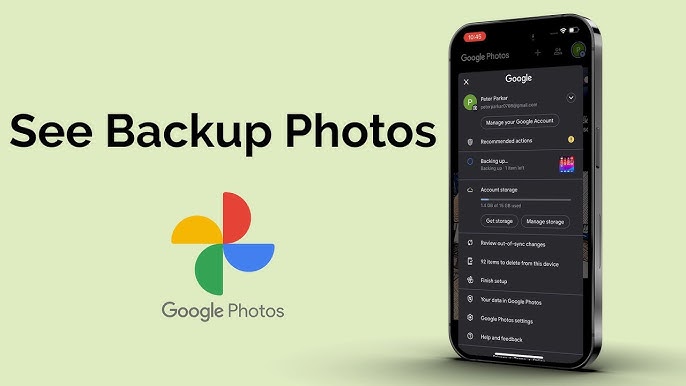The Best Features of Google Photos An Explainer: Google Photos is a cloud-based photo storage and organization service developed by Google. Launched in 2015, it offers users a platform to back up, organize, and share their photos and videos. One of its standout features is its unlimited storage for high-quality images (up to a specific resolution), although full-resolution storage counts against Google Drive’s space.
The service uses advanced artificial intelligence and machine learning to automatically categorize images. It recognizes people, places, and objects, making searching for a specific photo incredibly convenient. For example, typing “beach” or “birthday” in the search bar will pull up relevant images without the need for manual tagging.
Google Photos also provides powerful editing tools, allowing users to enhance images, apply filters, and create animations or collages from their photos. The app’s “Memories” feature highlights past moments by surfacing older photos on anniversaries or holidays, adding a nostalgic touch.
Users can easily share albums with friends and family, even if they don’t use Google Photos, via simple links. The app is available on mobile devices and the web, ensuring accessibility from anywhere. Google Photos combines cloud storage with intelligent organization and sharing, making it a popular choice for managing personal media collections.
Read Also: Effective Ways to Delete Your Google Search History
Key Features of Google Photos
- Unlimited Cloud Storage (With Quality Restrictions): Google Photos offers free unlimited storage for high-quality (compressed) images and videos up to a specific resolution. For original quality, storage is counted against your Google Drive limit.
- Automatic Backup and Sync: Photos and videos are automatically backed up across devices, ensuring they’re safe and accessible from anywhere.
- AI-Powered Organization: Google Photos uses artificial intelligence to sort images based on faces, places, objects, and events, making it easy to find specific photos through its powerful search capabilities.
- Memories and Highlights: Google Photos creates curated memories, resurfacing older photos based on anniversaries, trips, or past events, similar to social media features.
- Editing Tools: The platform includes built-in editing features, allowing users to crop, adjust lighting and color, add filters, and apply effects to enhance images.
- Photo and Album Sharing: Users can effortlessly share individual photos or entire albums with others using shareable links. Additionally, they have the option to collaborate on shared albums, allowing multiple people to contribute and view the collection.
- Automatic Creations: Google Photos can automatically generate animations, collages, videos, and photo books from your existing images.
- Google Lens Integration: With Google Lens, users can extract information from photos, such as text, product searches, or landmark identification.
- Storage Management Tools: Google Photos helps users free up space by identifying and deleting unwanted, blurry, or duplicate images.
- Cross-Platform Accessibility: The app is available on Android, iOS, and the web, ensuring access to your photos across devices.
Cloud Storage and Backup Options
Google Photos offers a robust cloud storage and backup system designed to ensure your photos and videos are safe, accessible, and well-organized. One of the service’s most attractive aspects is its automatic backup feature, which syncs your media across all your devices. Once you upload your photos to Google Photos, they are securely stored in the cloud. This process not only frees up space on your phone or computer but also ensures that your images are easily accessible from any device with an internet connection.
Google Photos provides two main storage options: “High Quality” and “Original Quality.” The High-Quality option allows for free unlimited storage of images and videos that are compressed to save space. Images are stored at up to 16 megapixels, and videos are reduced to 1080p resolution. While the compression is designed to preserve most of the original quality, it may be better for professional photographers or those who need to store uncompressed files.
For users who want to keep their photos in their original resolution, Google offers the Original Quality option, which stores images and videos without any loss in quality. However, these files count toward the user’s Google Drive storage quota. If the free 15 GB of Google Drive storage is insufficient, users can purchase additional storage through Google One, with plans starting at affordable rates for expanded space.
Sharing and Collaboration Made Simple
Google Photos simplifies sharing and collaboration, making it easy to connect with others through your photos and videos. The platform allows users to share individual images, videos, or entire albums with just a few clicks. One of its standout features is the ability to generate shareable links, which can be sent to anyone, even if they don’t have a Google Photos account. This eliminates the need for large file transfers via email or other cumbersome methods.
Shared albums also facilitate collaboration. Contribute their photos to an album, creating a collaborative collection of memories from events like vacations, weddings, or parties. When new images are added to a shared album, everyone in the group is notified, ensuring everyone stays updated.
Another handy feature is Live Albums, which automatically updates when new photos of specific people or pets are added. This is particularly useful for families who want to keep up-to-date with each other’s lives without having to manually share each photo.
Security and Privacy in Google Photos
Security and privacy are central to Google Photos, as the platform handles sensitive personal data like photos and videos. Google uses several measures to protect your media and ensure your privacy. All data stored in Google Photos is encrypted both in transit and at rest. This means that your photos are protected while being uploaded and when they are stored in the cloud.
In terms of privacy controls, Google Photos allows users to manage who can view their shared photos and albums. You can easily adjust sharing settings, either by sending private links to specific people or by revoking access at any time. Google also allows users to make their photos viewable only to selected contacts or restrict public access completely, ensuring that your media remains private.
Frequently Asked Questions
Does Google Photos compress my images?
Reduce file size and save space. The “Original Quality” option retains your files in their full resolution, but these will count against your Google Drive storage quota.
What happens if I delete a photo from Google Photos?
When you delete a photo from Google Photos, it moves to the Trash folder, where it stays for 60 days before being permanently removed. During this period, you can recover the photo if needed.
How secure are my photos in Google Photos?
Google Photos encrypts your media both in transit and at rest. For additional account security, you can also enable two-factor authentication (2FA).
Can I edit my photos in Google Photos?
Yes, Google Photos offers essential editing tools, including cropping, brightness adjustment, filters, and color correction.
How can I manage my Google Photos storage?
Google Photos includes tools to help you manage storage, such as identifying large videos, blurry images, or duplicates for deletion. If you need more space, you can also upgrade your Google Drive storage through Google One.
Conclusion
With its automatic backup feature, AI-driven organization, and seamless integration across devices, it offers a convenient way to manage your media library. Its free storage option with quality compression makes it accessible for casual users, while paid options provide flexibility for those who need original-quality storage. Google Photos simplifies sharing with others through easy-to-use links and collaborative albums while offering robust privacy and security features like encryption and two-factor authentication.

